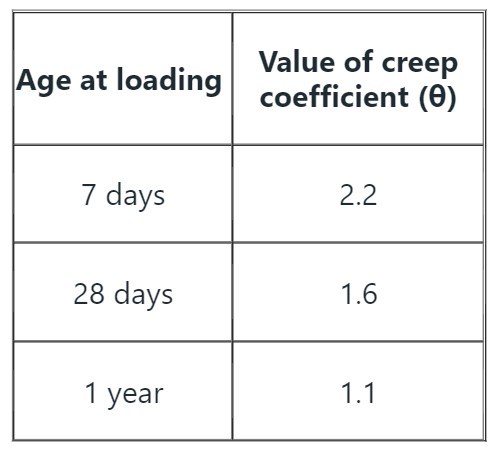Creep of Concrete
By BYJU'S Exam Prep
Updated on: September 25th, 2023

In concrete structures, as time passes, some permanent deformation has been observed in the different parts of the concrete structures. This permanent deformation is called the creep of concrete. Creep of concrete structures occurs over a long time due to the sustained loading over the years on a structure.
Creep of Concrete PDF [GATE Notes]
Creep will not occur due to the effect of live load over the structure; this deformation is called elastic or plastic deformation. The creep of concrete structures should lie within its permissible limit of deformation. If it exceeds the limit, the structure will not be used further. In this article, the creep of concrete will be covered in all aspects with detailed information.
Table of content
What is Creep of Concrete?
Creep of concrete is the permanent deformation reported in a part of a structure due to the sustained load for a long time. Creep indicates that strain in the structure continuously increases, but stress remains constant. Creep in a structure will depend on the structural material, loading quantity, loading duration, etc. Creep in concrete structures will be lesser than in steel structures.
Creep deformation generally occurs in 3 stages. These stages are called primary creep, secondary creep and tertiary creep. In the primary stage, concrete creep starts rapidly, and the rate decreases with time. In the secondary stage, creep generally occurs at a constant rate. And in the tertiary stage, creep starts at an increasing rate until the structural member breaks down.
Download Formulas for GATE Civil Engineering – Engineering Mechanics
Factors Affecting Creep of Concrete
As we discussed, creep is the permanent deformation caused by sustained loading. So based on the cause of the creep of concrete, it will depend on several factors. These factors govern the quality of the concrete material. These factors include the time depending loading factors and parameters related to manufacturing concrete material. Here a few factors are listed below on which the creep of concrete depends.
- Type of cement used for the construction of concrete material
- Quantity of cement used in the concrete
- Size and shape of the concrete material
- Amount of the reinforcing bars
- Surface-to-volume ratio
- The humidity of the surrounding atmosphere
- The temperature of the surrounding atmosphere
These above-mentioned factors also govern the overall strength of the concrete material.
Creep of Concrete Formula
The formula for the creep of concrete depends on several factors, including the creep coefficient and loading factors. Creep is the deformation induced in the structural member; hence it can be calculated by the following formula.
Creep of concrete = creep strain × length of the member.
Creep strain can be related to the modulus of elasticity of concrete at the age of the concrete.
The modulus of elasticity at a particular age of the concrete can be calculated as Ec=Es/(1+Θ)
Where Θ is the creep coefficient, which will depend on the age of the concrete.

Loss of Prestress Due to Creep of Concrete
In the case of prestressing, some amount of prestressing loss will occur due to concrete creep. The following parameters can obtain it. Loss of prestress due to the creep of the concrete is the product of ultimate creep strain and the modulus of elasticity of steel at the level of prestressing steel.
Other types of losses occur in prestressed concrete:
- Shrinkage of concrete
- Elastic shortening
- Frictional loss
- Creep of concrete
- Relaxation of steel
- Anchorage slip
Download Formulas for GATE Civil Engineering – Solid Mechanics
Difference Between Shrinkage and Creep of Concrete
Shrinkage and creep of concrete both the deformation of the concrete due to the sustained loading.
Creep is the permanent deformation of the concrete material caused by sustained loading over the concrete structures. The creep of concrete depends on the age of the concrete. As the age of the concrete increases, the creep of the concrete increase with the decreasing rate.
Due to the shrinkage effect of the concrete, it will either shrink or expand gradually. Shrinkage of the concrete occurs when some entrapped air exceeds out, or swelling of the concrete material occurs by any means.


